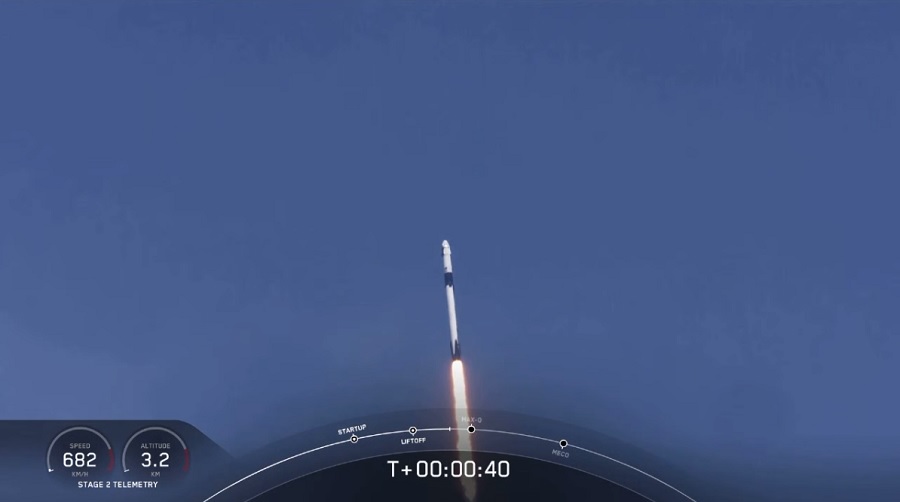The rocket launch with two astronauts was successful. America is back in the game. For Elon Musk and his company SpaceX this is a great triumph – for two others it is a heavy defeat. And what is Europe doing?

After two minutes and 56 seconds, Doug Hurley and Bob Behnken made history. This was how long it took her spaceship to reach a height of 100 kilometers – and thus to overcome the boundary of space.
The two men set off for the International Space Station (ISS) in Cape Canaveral, Florida on Saturday. Not like previous US astronauts with a space shuttle, but with the Dragon capsule from SpaceX, a company of billionaire Elon Musk. For the first time in almost nine years, a manned missile was launched in America. And for the first time ever, it was one built by a private company.
The choice of launch site already showed how important the mission called Demo-2 was: Hurley and Behnken, 53 and 49 years old, both test pilots, both shuttle veterans, took off from ramp 39A at 3:22 p.m. local time – that was where the start began First humans travel to the moon.
The minutes in which Hurley and Behnken rose on a fire tail into the sky over Florida, higher and higher, until they finally reached space – for Musk they were probably the most important of his career so far. In the past, the Dragon capsule only brought satellites into orbit, now two people.

Musk worked towards this moment for 18 years. He experienced an up and down with SpaceX for 18 years. Rockets exploded, some even before launch. Millions of dollars worth of satellites were torn to pieces. Sometimes a mission was successful, then everything went up in flames.
It was a difficult time, SpaceX had to gather the knowledge and money to get passengers into orbit – only governments could do that before. But the years ahead could be even more difficult.

Now, after the successful start, SpaceX and Nasa want to make such trips a lucrative business. For example, by taking tourists with them. “We’re trying to create a market in orbit,” said NASA chief Jim Bridenstine before Hurley and Behnken’s flight. “And we need SpaceX to attract customers outside of NASA.”
A space ticket for $ 55 million
But how realistic is that? Sure, SpaceX trips became cheaper. The reason is a revolutionary idea: rockets flopped into the ocean for a long time after just one launch, but the Falcon 9 can fly several times.
That changed the economy of the whole industry. Nevertheless, in the near future only wealthy adventurers will be able to afford a place in the Dragon capsule. NASA estimates the price per person at $ 55 million.
But Musk is not just about space tourism. For him, Demo-2 was a step towards another, even bigger goal. He wants to build a colony on Mars – as a plan B for humanity in the event of war or epidemics destroying the earth.
In a few years, a new, powerful rocket is to take off, the BFR. That stands for “Big Falcon Rocket”. Or – as Musk likes to suggest – “Big Fucking Rocket”. It is said to be the first spaceship to travel to other planets.
Musk was laughed at for such ideas for a long time. The established companies underestimated the man who often walks between genius and madness. But with Demo-2, Musk finally profiles itself as the leader of the New Space movement. The competitors, it seems, have now been left behind.
Hurley’s and Behnken’s start is mostly a loss for Boeing . With SpaceX, the group fought for the first manned flight to the ISS – and has now lost. Boeing disgraced itself in December 2019 when the still unmanned maiden flight of the CST-100 Starliner capsule had to be terminated prematurely due to technical problems. NASA made the company repeat the test flight before astronauts were allowed on board.
The end of the Russian monopoly
Internationally, the balance of power changed on Saturday, two minutes and 56 seconds after the start. Russia is the big loser here. After the space shuttle’s last flight in summer 2011, its Soyuz rocket was the only taxi to humanity’s outpost in space.
But this monopoly is now a thing of the past. For security, NASA had booked a return flight to the ISS with the Soyuz for $90 million. The Americans can now cancel that.
European manned rocket launches?
Europeans are just something of an observer on the edge of the field. They have no plans for their own manned rocket. Europe’s astronauts have to look for opportunities to fly and hitchhike across the galaxy.
The new Ariane 6 is not approved for manned flights. Because of the corona pandemic, the Europeans temporarily stopped all work on the rocket and the launch site in French Guiana. That has consequences. Ariane 6, according to the space agency ESA, will certainly not start this year. The rocket, developed under the direction of the Ariane Group (Airbus / Safran), was initially to take off in July, then it was said at the end of 2020 – and now in 2021.
The Europeans would also like to have a visionary like Elon Musk. The Federal Ministry of Economics and the German Aerospace Center has just launched a competition for small rockets. Start-ups and inventors can apply for money from a 25 million euro budget. At least a step towards space power. Musk started small too.









